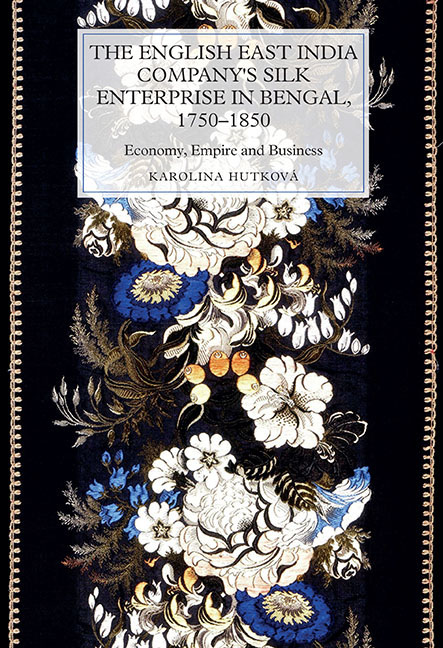Book contents
- Frontmatter
- Contents
- List of Illustrations
- Acknowledgements
- List of Abbreviations
- Measures and Currencies
- Introduction: Companies, Political Economy and the Great Divergenc
- Chapter 1 The Early Modern Silk Industry, Trade and Mercantilism
- Chapter 2 Empire, the English East India Company, and Bengal Raw Silk
- Chapter 3 Bengal, Piedmont and the English East India Company
- Chapter 4 The Bengal Silk Industry and the English East India Company
- Chapter 5 Filatures and Performance in the Bengal Silk Industry
- Chapter 6 The Bengal Silk Industry and British Laissez-Faire Policies
- Chapter 7 Bengal Raw Silk and British Demand in the Nineteenth Century
- Conclusion
- Appendix A Description of the Piedmontese Reeling Machine by Dionysius Lardner
- Appendix B Average Prices of Bengal Raw Silk on the British Market According to the Type of the Silk, 1796–1856
- Appendix C Return on Investment Analysis
- Appendix D Comparison of Manufacturing Costs at the EEIC's Experimental Filature and Common Filature in its Vicinity, 1832
- Appendix E Mechanisation of Silk Throwing and Weaving in England and Scotland, 1856
- Appendix F Types of Silkworm Reared in Bengal Silk Districts, 1818
- Appendix G Glossary
- Bibliography
- Index
- WORLDS OF THE EAST INDIA COMPANY
Chapter 6 - The Bengal Silk Industry and British Laissez-Faire Policies
Published online by Cambridge University Press: 31 August 2019
- Frontmatter
- Contents
- List of Illustrations
- Acknowledgements
- List of Abbreviations
- Measures and Currencies
- Introduction: Companies, Political Economy and the Great Divergenc
- Chapter 1 The Early Modern Silk Industry, Trade and Mercantilism
- Chapter 2 Empire, the English East India Company, and Bengal Raw Silk
- Chapter 3 Bengal, Piedmont and the English East India Company
- Chapter 4 The Bengal Silk Industry and the English East India Company
- Chapter 5 Filatures and Performance in the Bengal Silk Industry
- Chapter 6 The Bengal Silk Industry and British Laissez-Faire Policies
- Chapter 7 Bengal Raw Silk and British Demand in the Nineteenth Century
- Conclusion
- Appendix A Description of the Piedmontese Reeling Machine by Dionysius Lardner
- Appendix B Average Prices of Bengal Raw Silk on the British Market According to the Type of the Silk, 1796–1856
- Appendix C Return on Investment Analysis
- Appendix D Comparison of Manufacturing Costs at the EEIC's Experimental Filature and Common Filature in its Vicinity, 1832
- Appendix E Mechanisation of Silk Throwing and Weaving in England and Scotland, 1856
- Appendix F Types of Silkworm Reared in Bengal Silk Districts, 1818
- Appendix G Glossary
- Bibliography
- Index
- WORLDS OF THE EAST INDIA COMPANY
Summary
Nineteenth-century textile production was characterised by innovations in technology and management. Europe led the way in cotton and silk production – Britain in cotton, Italy and France in silk – and aspiring textile producers were importing new technologies and adapting them. In the second part of the nineteenth century, raw silk production spread to new areas, most importantly to Japan but also to Egypt. These new producers could not rely solely on cheap labour as standardisation of the quality of raw silk was becoming increasingly important, especially with the rise of mechanised silk weaving in the USA. Importation of advanced technologies of silk reeling was thus a necessity. The most successful newcomer to raw silk production was Japan. It was one of the leaders in catching up with the major producers of both cotton and silk, and it relied on imported technologies as well as on domestic innovations and adaptations. Technological upgrading in Japan was assisted by the state as well as large entrepreneurs. Both the state and large producers provided entrepreneurial guidance about new technologies, best practices in production and management, and information about faraway markets. Merchant networks and domestic banks were instrumental in the provision of credit.
At the time when Japan started to import silk technologies, Bengal was some steps in front as it already possessed a system of filatures producing raw silk with the use of European technologies adapted to local conditions. Yet instead of surging further ahead, Bengal raw silk production fell behind its competitors, and by the end of the nineteenth century it had lost its position in European silk weaving. Bengal raw silk as a share of total imports of raw silk to Britain declined from around 40 per cent in the period from the 1790s to the 1810s to around 13 per cent in the 1860s. To explain this shift we need to look at changes in the political economy in Britain and consider the role of the English East India Company in silk manufacturing in the period from the 1770s to the 1830s. The beginning of the nineteenth century marked a change from mercantilism to laissez-faire policies in the British political economy. Laissez-faire policies were promoted by a number of economists, pamphleteers and politicians, most notably by David Ricardo, an MP at the time (1818–23).
- Type
- Chapter
- Information
- The English East India Company's Silk Enterprise in Bengal, 1750–1850Economy, Empire and Business, pp. 145 - 172Publisher: Boydell & BrewerPrint publication year: 2019



